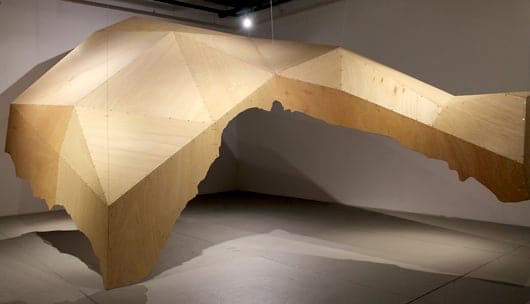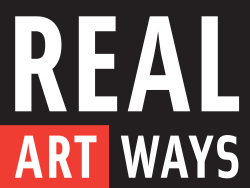Event

Kurt Steger: Scribing the Void
Scribing the Void is a monumental sculpture transcribed from a Central Park boulder and initially installed at ODETTA gallery in Brooklyn, New York. At Real Art Ways, it is again suspended in the exact north-south orientation, level line and elevation as it would sit on the boulder. The sculpture moves almost imperceptibly with the air currents in the gallery.
The scribe line was achieved after multiple trips to the Central Park site, methodically tracing and cutting the shape of the boulder’s surface onto chipboard templates, resulting in 82 linear feet of a single contour line. This line was then copied onto the wooden superstructure that was transported and reassembled at the gallery.
The composer RSM was invited to create a score that was composed by placing the scribe line of the boulder onto a musical staff, effectively writing the song of the rock. RSM then took these notes and recorded the composition. The Byzantine-inspired sounds of piano, violin, drum, and voice permeate the empty space.
A recent pilgrimage to Mt. Kailash in western Tibet inspired much of Steger’s conceptual thoughts behind the sculpture: materiality versus immateriality, questions of time and space, and perceptions of memory beyond the familiar senses are addressed in Scribing the Void. The scribe line represents the divide between spirit and matter, the line between birth and death. Void speaks of loss, our severed connection to nature, community and ancestry, separation from our inner lives, and the mystery of existence.
Artist’s Statement
I have always been interested in the natural world and its interrelationship with the human psyche. My concern began at a young age, when I saw the “Crying Indian” commercial on TV, which warned against pollution and environmental loss. It touched me deeply, and my creative work is an expression of an ongoing concern for our planet.
My sculptures are constructed using traditional materials such as wood, paper, concrete, and steel. I often incorporate impermanent elements – ice, fire, erosion, and gravity – which leave their mark and allude to the passage of time. The stain left by the fugitive materials refers to the destruction of nature, and the devastating imprint that humans have imposed on the environment.
I was trained as a carpenter and woodworker. I value the beauty of craftsmanship, as well as the importance of ritual, and bring both elements into my work. Beyond the physicality of the object that I create, there are the invisible agents that speak to the heart. Working by hand, I combine knowledge and intuition, bridging the gap between mind and heart. My work addresses our need to reconnect with nature in order to heal the primal wounds of the human psyche.
Curated by David Borawski
